Thermomechanical Analysis of Thermoplastic Mono-Material Sandwich Structures with Honeycomb Core
Abstract
:1. Introduction
2. Materials and Methods
2.1. Materials and Manufacturing
2.2. Theoretical Background of Thermoforming
2.3. Material Characterization
2.3.1. Bias Extension Test
2.3.2. Test Setup
2.4. Thermoforming Model
3. Results
3.1. Material Characterization
3.2. Thermomechanical Analysis
4. Discussion
5. Conclusions
Author Contributions
Funding
Data Availability Statement
Conflicts of Interest
References
- Brandon, G.; Zhang, K.; Rutherford, D. CO2 Emissions from Commercial Aviation; Working Paper 2019-16; International Council on Clean Transportation (ICCT): Washington, DC, USA, 2018. [Google Scholar]
- International Civil Aviation Organization (ICAO). Report of the High-Level Meeting on the Feasibility of a Long-Term Aspirational Goal for International Aviation CO2 Emissions Reductions; Doc 10178; International Civil Aviation Organization (ICAO): Montréal, QC, Canada, 2022. [Google Scholar]
- International Air Transport Association (IATA). Factsheet: CORSIA. Available online: https://www.iata.org/en/iata-repository/pressroom/fact-sheets/fact-sheet---corsia/ (accessed on 20 December 2022).
- Grünewald, J.; Parlevliet, P.P.; Altstädt, V. Manufacturing of Thermoplastic Composite Sandwich Structures: A Review of Literature. J. Thermoplast. Compos. Mater. 2017, 30, 437–464. [Google Scholar] [CrossRef]
- Neumeyer, T.; Kroeger, T.; Knoechel, J.F.; Schreier, P.; Muehlbacher, M.; Altstaedt, V. Thermoplastic Sandwich Structures-Processing Approaches Towards Automotive Serial Production. In Proceedings of the 21st International Conference on Composite Materials, Xi’an, China, 20–25 August 2017. [Google Scholar]
- Rozant, O.; Bourban, P.-E.; Månson, J.-A.E. Manufacturing of three-dimensional sandwich parts by direct thermoforming. J. Compos. Part A Appl. Sci. Manuf. 2001, 32, 1593–1601. [Google Scholar] [CrossRef]
- Trende, A.; Åström, B.T. Heat Transfer in Compression Molding of Thermoplastic Composite Laminates and Sandwich Panels. J. Thermoplast. Compos. Mater. 2002, 15, 43–63. [Google Scholar] [CrossRef]
- Latsuzbaya, T.; Middendorf, P.; Voelkle, D.; Weber, C. Thermoforming of Thermoplastic Mono-Material Sandwich Structures with Honeycomb Core. In Proceedings of the SAMPE Conference, Charlotte, NC, USA, 23–26 May 2022. [Google Scholar]
- Rozant, O.; Bourban, P.-E.; Månson, J.-A.E. Pre-Heating of Thermoplastic Sandwich Materials for Rapid Thermoforming. J. Thermoplast. Compos. Mater. 2000, 13, 510–523. [Google Scholar] [CrossRef]
- TenCate Cetex System3: Aerospace Composites–Product Outline Airspace Interiors. Available online: https://www.yum-pu.com/en/document/view/4368085/header-tencate/2 (accessed on 20 December 2022).
- Kulandaivel, P. Manufacturing and Performance of Thermoplastic Composite Sandwich Structures. Ph.D. Thesis, University of Nottingham, Nottingham, UK, 2006. [Google Scholar]
- Skawinski, O.; Binetruy, C.; Krawczak, P.; Grando, J.; Bonneau, E. All-thermoplastic Composite Sandwich Panels–Part I: Manufacturing and Improvement of Surface Quality. J. Sandw. Struct. Mater. 2004, 6, 399–420. [Google Scholar] [CrossRef]
- Åkermo, M.; Åström, B.T. Experimental Investigation of Compression Molding of Glass/PP-PP Foam Core Sandwich Components. J. Thermoplast. Compos. Mater. 1999, 12, 297–316. [Google Scholar] [CrossRef]
- MAI Sandwich–Entwicklung von Thermoplastisch Fügbaren Sandwichstrukturen unter Berücksichtigung Eines Sortenreinen und Wiederverwendbaren Werkstoffeinsatzes. Abschlussbericht 2017. Available online: https://www.tib.eu/en/sea-rch/id/TIBKAT:1010424319/ (accessed on 20 December 2022).
- Rozant, O.; Bourban, P.-E.; Månson, J.-A.E. Experimental and Numerical Investigations of the Forming of Thermoplastic Sandwiches. In Proceedings of the 12th ICCM Conference, Paris, France, 5–9 July 1999. [Google Scholar]
- Minupala, V.K.; Gläßer, T.; Zscheyge, M. Simulation of Thermoforming Process of Thermoplastic based Sandwich Laminates made of Cross-ply and Honeycomb Core. In Proceedings of the 5th ITHEC 2020 Conference, Bremen, Germany, 13–14 October 2020. [Google Scholar]
- Guzman-Maldonado, E.; Hamila, N.; Boisse, P.; Bikard, J. Thermomechanical Analysis, Modelling and Simulation of the Forming of Pre-impregnated Thermoplastic Composites. J. Compos. Part A Appl. Sci. Manuf. 2015, 78, 211–222. [Google Scholar] [CrossRef]
- Ramirez, J.P.B.; Palaniswamy, H.; Roy, S. Numerical Modelling of Thermoplastic Resin Behavior for Thermoforming of Laminates Composed of Non-crimp Fabrics. In Proceedings of the 11th International Conference and Workshop on Numerical Simulation of 3D Sheet Metal Forming Processes, Tokyo, Japan, 30 July–3 August 2018. [Google Scholar]
- Tabiei, A.; Murugesan, R. Thermal Structural Forming Simulation of Carbon and Glass Fiber Reinforced Plastics Composites. Int. J. Compos. Mater. 2015, 5, 182–194. [Google Scholar]
- Boisse, P.; Hamila, N.; Vidal-Sallé, E.; Dumont, F. Simulation of Wrinkling during Textile Composite Reinforcement Forming. Influence of Tensile, In-plane Shear and Bending Stiffnesses. J. Compos. Sci. Technol. 2011, 71, 683–692. [Google Scholar] [CrossRef]
- Hamila, N.; Boisse, P.; Sabourin, F.; Brunet, M. A Semi-discrete Shell Element for Textile Composite Reinforcement Forming Simulation. Int. J. Numer. Methods Eng. 2009, 79, 1443–1466. [Google Scholar] [CrossRef]
- Long, A.C. Process Modelling for Textile Composite. In Proceedings of the International Conference on Virtual Prototyping EUROPAM, Nantes, France, 12–13 October 2000. [Google Scholar]
- Toray. Datasheet Cetex® TC925 FST PC. 20 November 2019. Available online: https://www.toraytac.com/media/ed2cc738-5073-47e1-a093-ff3fbe7ca715/3Qcuqg/TAC/Documents/Data_sheets/Thermoplastic/UD%20tapes,%20prepregs%20and%20laminates/Toray-Cetex-TC925-FST_PC_PDS.pdf (accessed on 9 July 2023).
- Tubus-Bauer. Datasheet PC Core. 23 May 2007. Available online: https://www.tubus-bauer.com/media/datenblattpc_wabe_polycarbonat.pdf (accessed on 9 July 2023).
- Thor, M.; Sause, M.G.R.; Hinterhölzl, R. Mechanisms of Origin and Classification of Out-of-Plane Fiber Waviness in Composite Materials—A Review. J. Compos. Sci. 2020, 4, 130. [Google Scholar] [CrossRef]
- Prodromou, A.G.; Chen, J. On the Relationship between Shear Angle and Wrinkling of Textile Composite Preforms. J. Compos. Part A Appl. Sci. Manuf. 1997, 28, 491–503. [Google Scholar] [CrossRef]
- Allaoui, S.; Hivet, G.; Soulat, D.; Wendling, A.; Ouagne, P.; Chatel, S. Experimental Preforming of Highly Double Curved Shapes with a Case Corner Using an Interlock Reinforcement. Int. J. Mater. Form. 2014, 2, 155–165. [Google Scholar] [CrossRef]
- Spivak, S.M.; Treloar, L.R.G. The Behavior of Fabrics in Shear. Part III: The Relationship between Bias Extension and Simple Shear. J. Text. Res. 1968, 38, 963–971. [Google Scholar] [CrossRef]
- Boisse, P.; Hamila, N.; Guzman-Maldonado, E.; Madeo, A.; Hivet, G.; Dell’Isola, F. The Bias-Extension Test for the Analysis of In-Plane Shear Properties of Textile Composite Reinforcements and Prepregs: A Review. Int. J. Mater. Form. 2017, 10, 473–492. [Google Scholar] [CrossRef]
- Gupta, Y.N.; Chakraborty, A.; Pandey, G.D.; Setua, D.K. Thermal and Thermooxidative Degradation of Engineering Thermoplastics and Life Estimation. J. Appl. Polym. Sci. 2004, 92, 1737–1748. [Google Scholar] [CrossRef]
- Cao, J.; Akkerman, R.; Boisse, P.; Chen, J.; Cheng, H.S.; De Graaf, E.F.; Gorczyca, J.L.; Harrison, P.; Hivet, G.; Launay, J.; et al. Characterization of Mechanical Behavior of Woven Fabrics: Experimental Methods and Benchmark Results. J. Compos. Part A Appl. Sci. Manuf. 2008, 39, 1037–1053. [Google Scholar] [CrossRef]
- Dridi, S.; Mabrouki, T.; Morestin, F.; Dogui, A.; Boisse, P. Experimental Analysis of Bias Extension and Picture Frame Tests for Woven Fabric by Digital Image Correlation. In Proceedings of the Third International Conference of Applied Research in Textile CIRAT-3, Sousse, Tunisia, 13–16 November 2008. [Google Scholar]
- Brands, D.; Wijskamp, S.; Grouve, W.J.B.; Akkerman, R. In-Plane Shear Characterization of Unidirectional Fiber Reinforced Thermoplastic Tape Using the Bias Extension Method. J. Front. Mater. 2022, 9, 863952. [Google Scholar] [CrossRef]
- Vanclooster, K. Forming of Multilayered Fabric Reinforced Thermoplastic Composites; University Leuven: Leuven, Belgium, 2010; ISBN 978-94-6018-223-5. [Google Scholar]
- Altair Engineering Inc. RADIOSS User’s Manual, Version 2017; Altair Engineering Inc.: Troy, MI, USA, 2017. [Google Scholar]
- Richeton, J.; Ahzi, S.; Vecchio, K.S.; Jiang, F.C.; Adharapurapu, R.R. Influence of temperature and strain rate on the mechanical behavior of three amorphous polymers: Characterization and modeling of the compressive yield stress. Int. J. Solids Struct. 2006, 43, 2318–2335. [Google Scholar] [CrossRef]
- Durville, D. Simulation of the Mechanical Behavior of Woven Fabrics at the Scale of Fibers. Int. J. Mater. Form. 2010, 3, 1241–1251. [Google Scholar] [CrossRef]
- Gatouillat, S.; Bareggi, A.; Vidal-Sallé, E.; Boisse, P. Meso Modelling for Composite Preform Shaping–Simulation of the Loss of Cohesion of the Woven Fibre Network. J. Compos. Part A Appl. Sci. Manuf. 2013, 54, 135–144. [Google Scholar] [CrossRef]
- Hamila, N.; Boisse, P. Simulations of Textile Composite Reinforcements Draping using a New Semi-discrete Three Node Finite Element. J. Compos. Part B Eng. 2009, 39, 999–1010. [Google Scholar] [CrossRef]
- Schramm, N.; Iwan, S.; Trikov, V.; Erhart, F. Prozess- und Struktursimulation von endlosfaserverstärkten thermoplastischen Karosseriebauteilen. In Proceedings of the 11th Saxon Simulation Meeting, Chemnitz, Germany, 26 March 2019; ISBN 978-3-96100-078-4. [Google Scholar]
- Prus, C.; Vinuesa, R.; Schlatter, P.; Tembras, E.; Mestres, E.; Ramirez, J.P.B. Impact Simulation and Optimisation of Elastic Fuel Tanks Reinforced with Exoskeleton for Aerospace Applications. Int. J. Crashworthiness 2017, 22, 271–293. [Google Scholar] [CrossRef]
- DIN EN ISO 1183-1; Plastics—Methods for Determining the Density of non-Cellular Plastics—Part 1: Immersion method, Liquid Pycnometer Method and Titration Method. Deutsches Institut für Normierung E. V.: Berlin, Germany; Beuth Verlag GmbH: Berlin, Germany, 2019.
- DIN EN ISO 527-2; Plastics—Determination of Tensile Properties—Part 2: Test Conditions for Moulding and Extrusion Plastics. Deutsches Institut für Normierung E. V.: Berlin, Germany; Beuth Verlag GmbH: Berlin, Germany, 2012.
- DIN EN ISO 11357-4; Plastics—Differential Scanning Calorimetry (DSC)—Part 4: Determination of Specific Heat Capacity. Deutsches Institut für Normierung E. V.: Berlin, Germany; Beuth Verlag GmbH: Berlin, Germany, 2021.
- ASTM E1461-13; Standard Test Method for Thermal Diffusivity by the Flash Method. ASTM International: West Conshohocken, PA, USA, 2022.
- ASTM C518-21; Standard Test Method for Steady-State Thermal Transmission Properties by Means of the Heat Flow Meter Apparatus. ASTM International: West Conshohocken, PA, USA, 2021.
- English, S.; Brown, A.; Briggs, T. A Micro to Macro Approach to Polymer Matrix Composites Damage Modeling: Final LDRD Report; Sandia National Laboratories: Albuquerque, NM, USA, 2013.
- DIN EN 2747-3; Aerospace Series—Glass Fibre Reinforced Plastics—Tensile Test. Deutsches Institut für Normierung E. V.: Berlin, Germany; Beuth Verlag GmbH: Berlin, Germany, 1998.
- DIN EN 6031; Aerospace Series—Fibre Reinforced Plastics—Test Method—Determination of in-Plane Shear Properties (±45° Tensile Test). Deutsches Institut für Normierung E. V.: Berlin, Germany; Beuth Verlag GmbH: Berlin, Germany, 2016.
- Graef, J.; Weiß, B.; Engel, B. Measurement of Fiber Wrinkles and Shear Angles of Double Dome Forming Parts. In Proceedings of the 24th International Conference on Material Forming ESAFORM21, Liège, Belgium, 14–16 April 2021. [Google Scholar]
- De Gennes, P.G. Reptation of a Polymer Chain in the Presence of Fixed Obstacles. J. Chem. Phys. 1971, 55, 572–579. [Google Scholar] [CrossRef]
- Akkerman, R.; Haanappel, S.P.; Sachs, U. History and Future of Composites Forming Analysis. In Proceedings of the 13th International Conference on Textile Composites TEXCOMP-13, Milan, Italy, 17–19 September 2018. [Google Scholar]
- Krämer, E.T.M.; Grouve, W.J.B.; Koussios, S.; Warnet, L.L.; Akkerman, R. Real-time observation of waviness formation during C/PEEK consolidation. J. Compos. Part A Appl. Sci. Manuf. 2020, 133, 105872. [Google Scholar] [CrossRef]



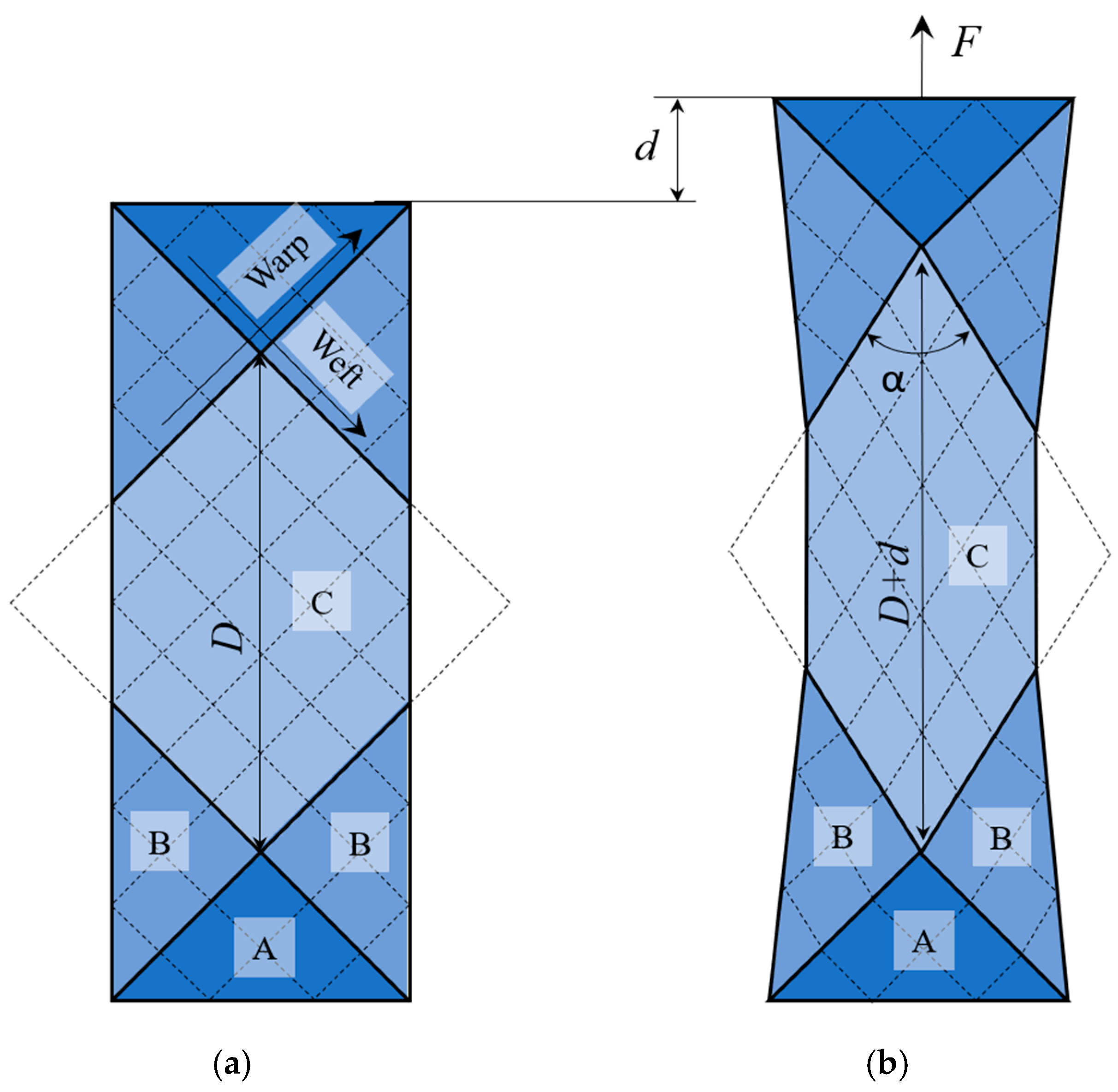
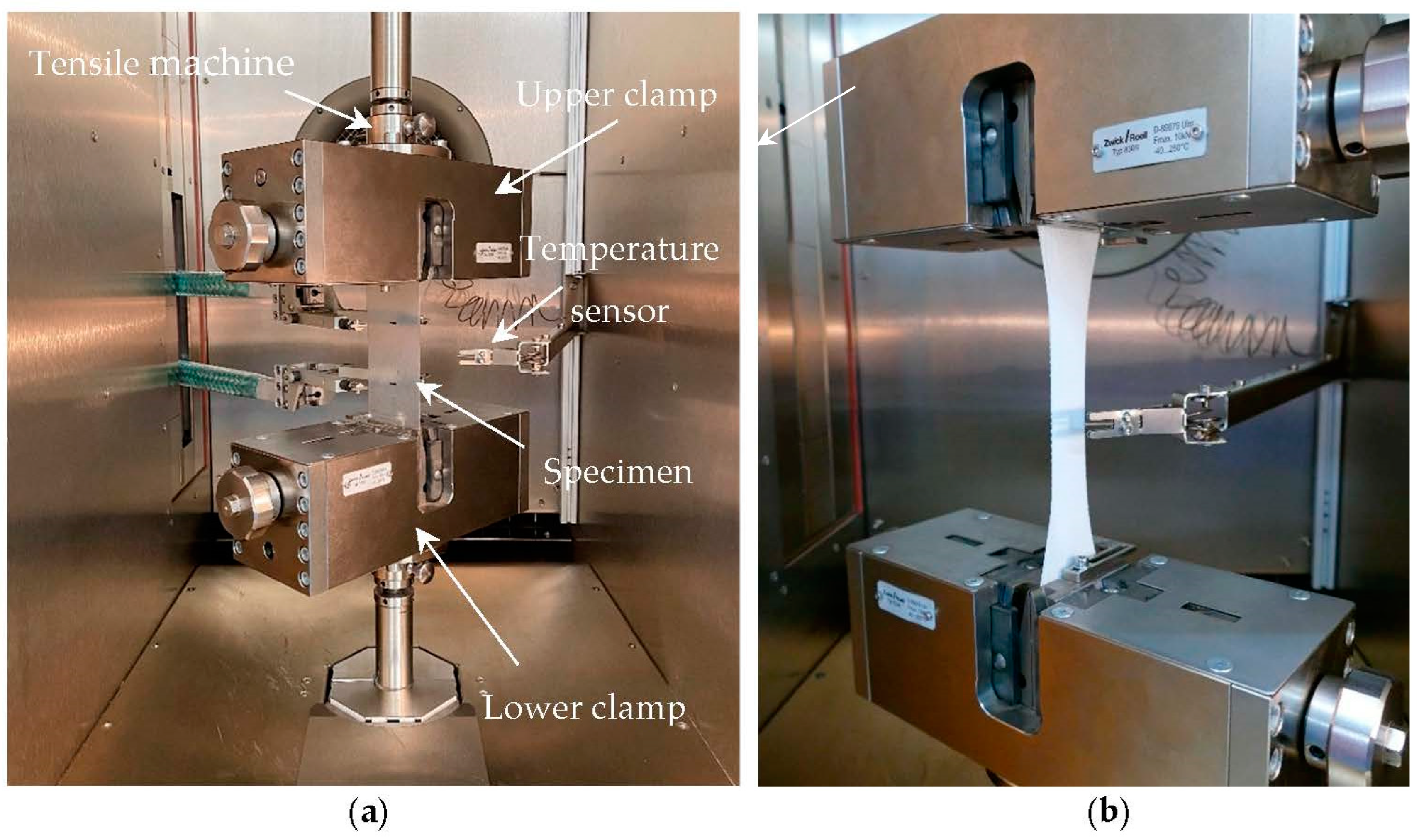




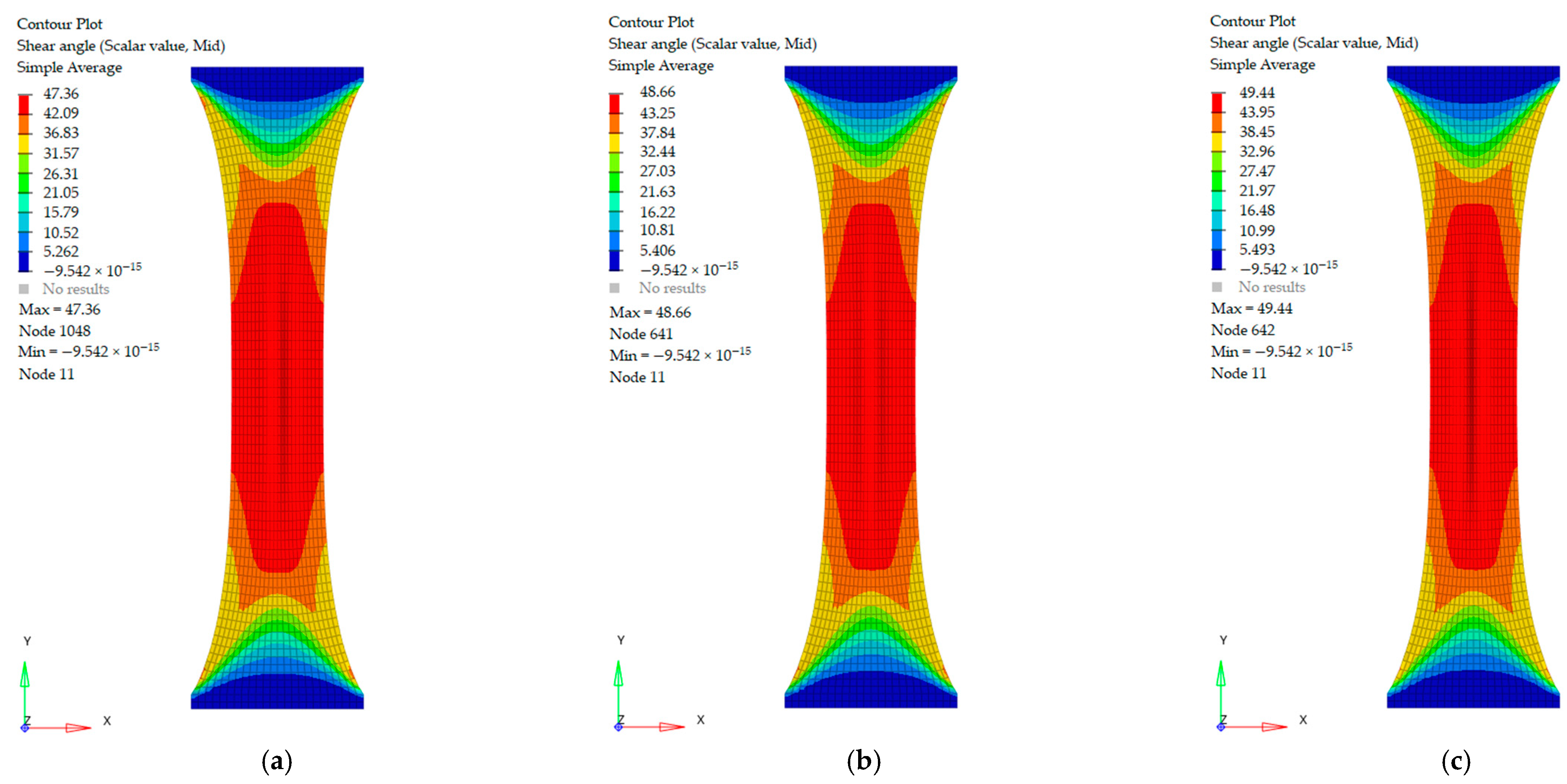



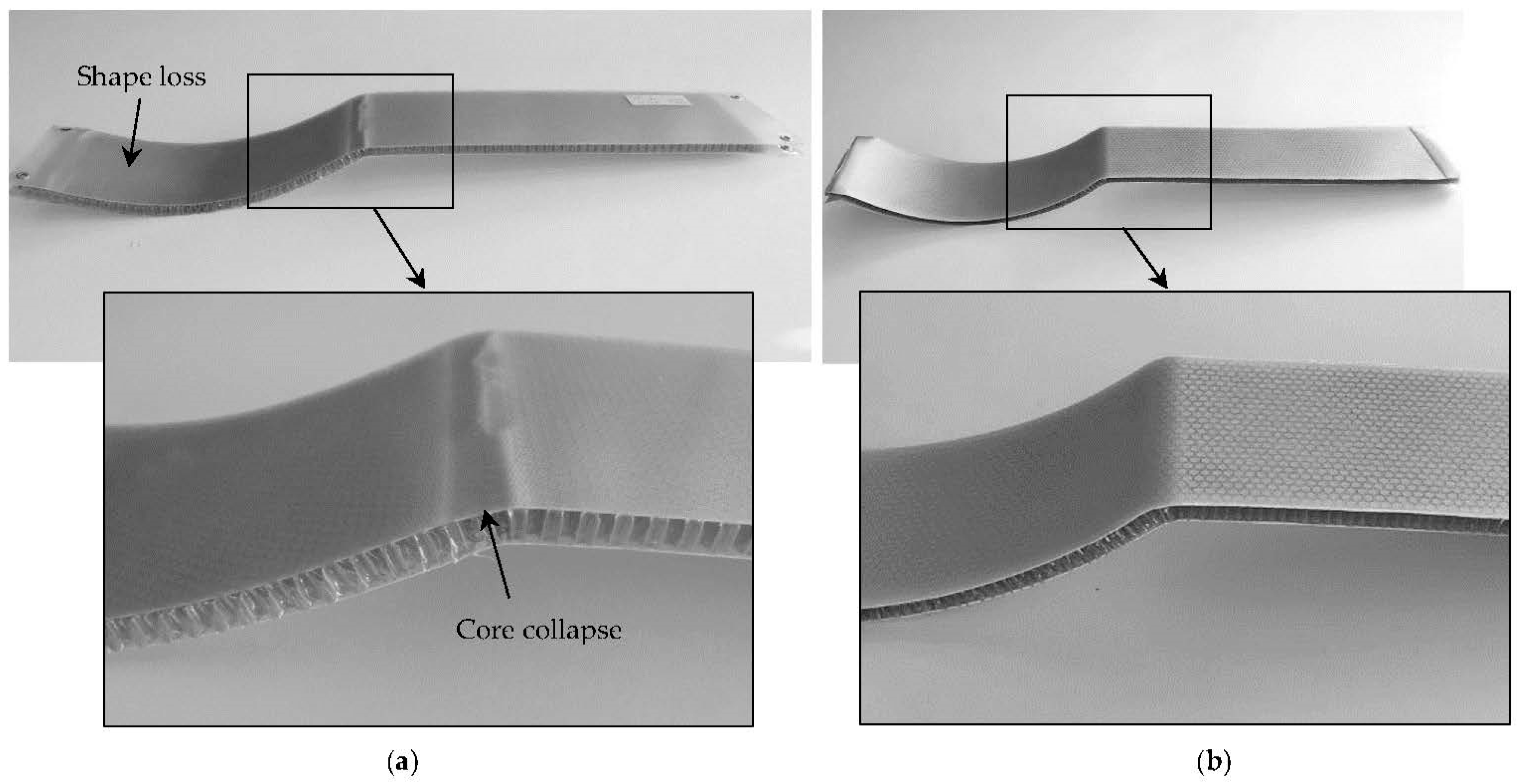

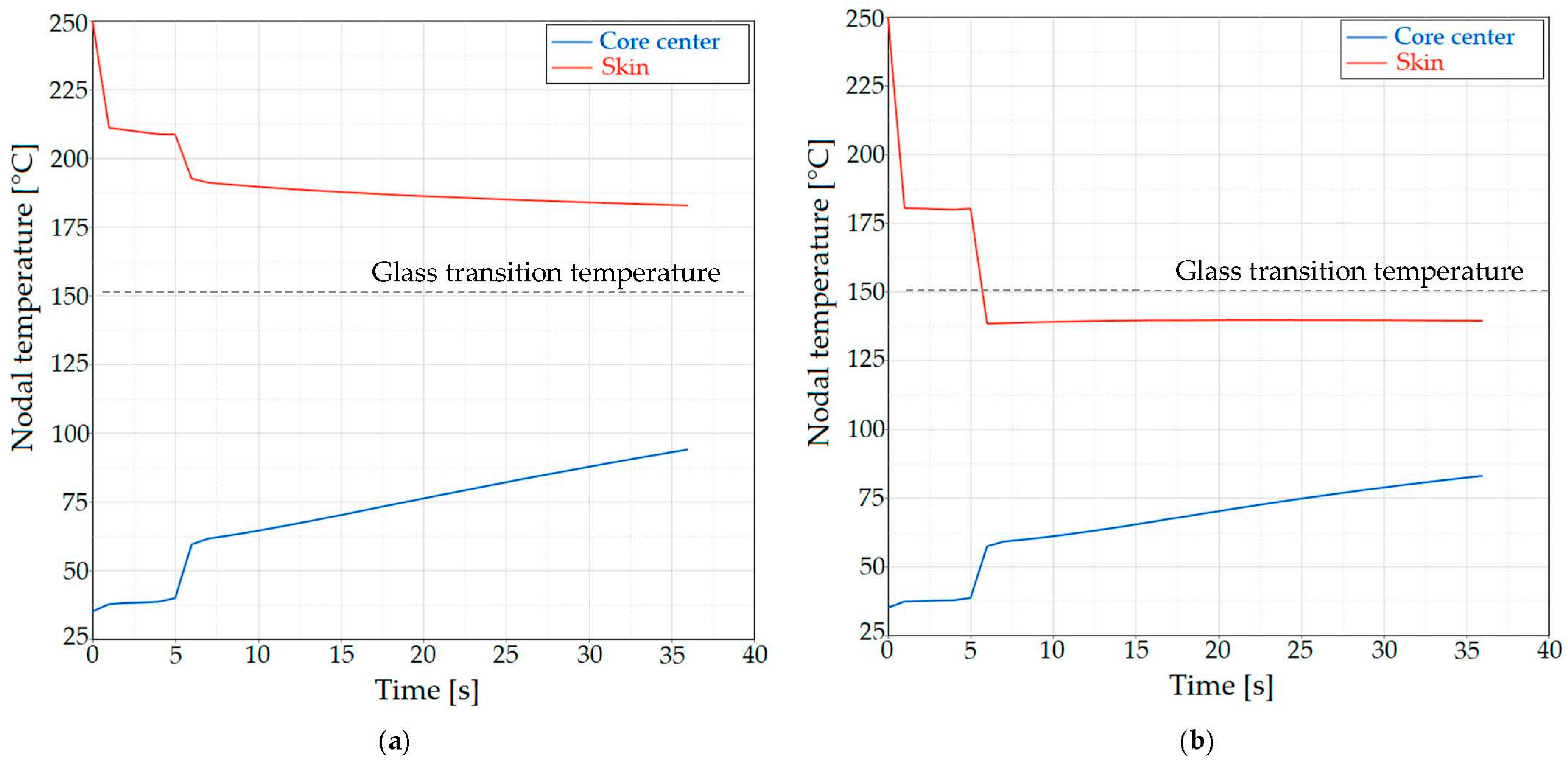
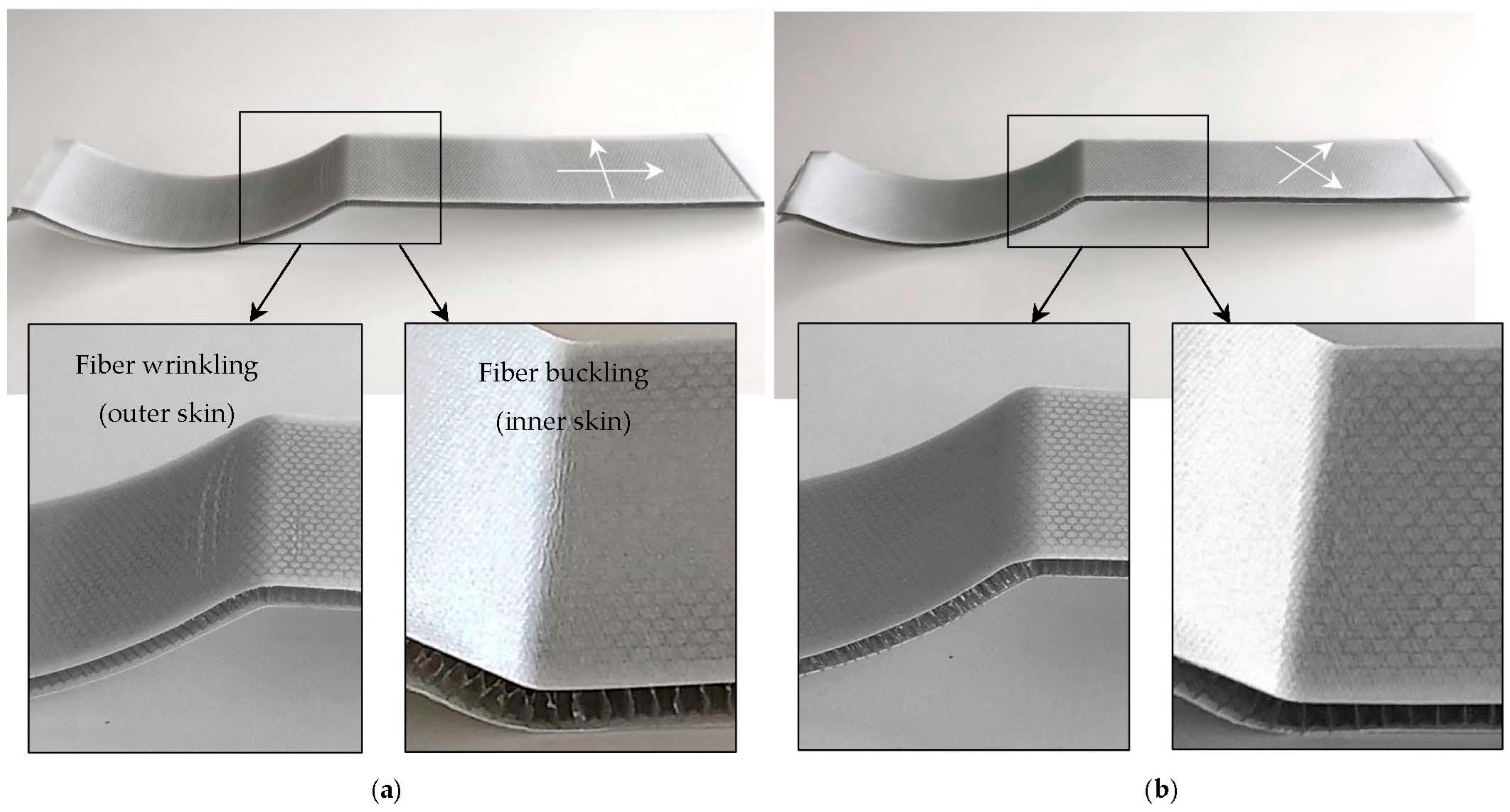

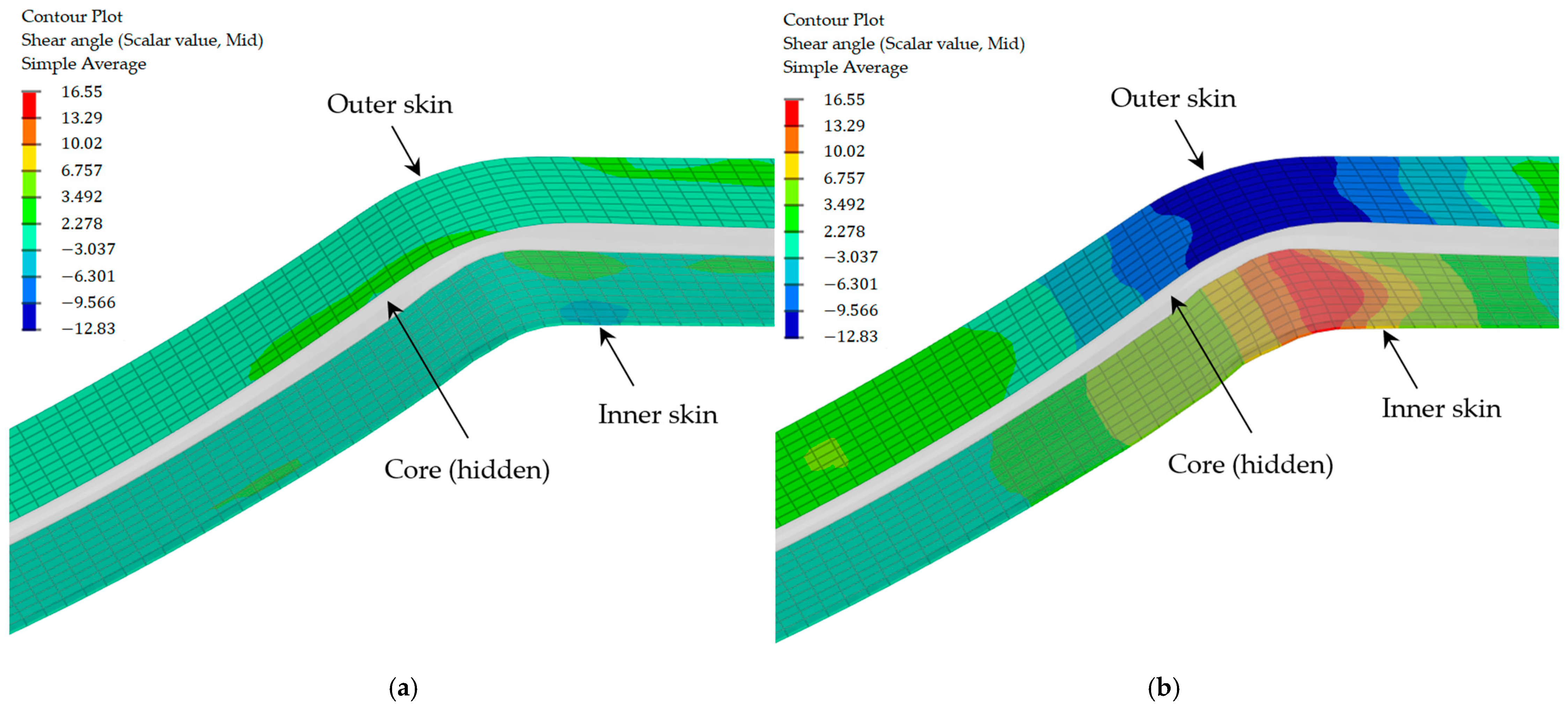

| Property | Polycarbonate (Skin Matrix Law 73 and Core Law 74) | Test Standard | Woven Fabric (Law 58) | Test Standard |
|---|---|---|---|---|
| Density (kg/m3) | 1330 | ISO 1183-1 [42] | 2600 | ISO 1183-1 [42] |
| Young modulus (MPa) | 2600 | ISO 527-2 [43] | - | - |
| Poisson ratio | 0.38 | ISO 527-2 [43] | - | - |
| Young modulus in warp direction (GPa) | - | - | 23.7 [23] | EN 2747-3 [48] |
| Young modulus in weft direction (GPa) | - | - | 24.1 [23] | EN 2747-3 [48] |
| Shear modulus (GPa) | - | - | 3.4 [23] | EN 6031 [49] |
| Thermal conductivity (W/m-°C) | 0.2 | ASTM E1461 [45] | 0.24 | ASTM C518 [46] |
| Specific heat capacity (J/kg-°C) | 1630 | ISO 11357-4 [44] | 810 | ISO 11357-4 [44] |
Disclaimer/Publisher’s Note: The statements, opinions and data contained in all publications are solely those of the individual author(s) and contributor(s) and not of MDPI and/or the editor(s). MDPI and/or the editor(s) disclaim responsibility for any injury to people or property resulting from any ideas, methods, instructions or products referred to in the content. |
© 2024 by the authors. Licensee MDPI, Basel, Switzerland. This article is an open access article distributed under the terms and conditions of the Creative Commons Attribution (CC BY) license (https://creativecommons.org/licenses/by/4.0/).
Share and Cite
Latsuzbaya, T.; Middendorf, P.; Voelkle, D.; Weber, C. Thermomechanical Analysis of Thermoplastic Mono-Material Sandwich Structures with Honeycomb Core. J. Compos. Sci. 2024, 8, 18. https://doi.org/10.3390/jcs8010018
Latsuzbaya T, Middendorf P, Voelkle D, Weber C. Thermomechanical Analysis of Thermoplastic Mono-Material Sandwich Structures with Honeycomb Core. Journal of Composites Science. 2024; 8(1):18. https://doi.org/10.3390/jcs8010018
Chicago/Turabian StyleLatsuzbaya, Temuri, Peter Middendorf, Dietmar Voelkle, and Christoph Weber. 2024. "Thermomechanical Analysis of Thermoplastic Mono-Material Sandwich Structures with Honeycomb Core" Journal of Composites Science 8, no. 1: 18. https://doi.org/10.3390/jcs8010018






